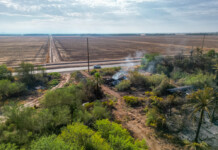
Wayne Naegle’s land is constantly at work. The plots are either pushing up the latest produce or are preparing for the next sowing. Acres south of Maricopa that were once cotton fields continue to be productive year-round for an octogenarian who knows how to toil in the soil, even in winter.
“All you need is a little space, soil and water,” Naegle says.
His winter crops include romaine lettuce, cabbage, kale, broccoli and greens and root vegetables like carrots, radishes, onions, garlic and beets. His flowers draw bees and butterflies in December, and his citrus trees are heavy with fruit. While gardeners from other parts of the country may think winter is the time to rest, Naegle has harvesting and prepping to do.
Next to his plots of greens ready for harvesting and sweet onions just breaking the surface, another plot has been tilled and put on slow-drip irrigation for future crops. “A man can grow darn near everything he wants to eat in that space,” he says.
Master Gardener Julie Olsen of the University of Arizona’s Cooperative Extension Office agrees. In her own 4-by-8 foot raised bed, with the right planning, she has just what she needs. For Olsen and Master Gardener Dave Brady, Naegle’s garden is the example of what can be accomplished in the Maricopa ecosystem.
They offer tips for a healthy winter garden:
1. Location, location. Though it seems obvious, plants need sunlight. Novice gardeners can fear the Arizona sun, even in winter, and plant in an area of too much shade. A spot with plenty of morning light and some afternoon shade is best, the Extension recommends. Six to eight hours of sun is prime for most vegetables. Don’t plant vegetables in the narrow shaded space between houses and walls.
“Don’t plant under a tree,” Olsen says. Trees and shrubs not only block the sun, but their roots also rob other plants of soil and water.
Well before planting, sketch out a plan of your garden, deciding the best location for the vegetables and flowers you want. Olsen says while some plants may combat each other, others complement each other.
2. Soil preparation. Soil in this area tends to have a lack of organic matter, with pH too high, and too many salts. After generations of cotton farming was followed by years of no farming activity, micro-organisms had time to consume what organic matter there was in the soil, according to Richard Gibson, the county Extension agent.
“You have to leach the place,” Naegle says. “That will force the salts below the root level. The compost or manure will take care of the organic matter.”
Brady says using a combination of fertilizers is common to get the right balance. Straight manure can be full of weed seed, but composted manure rarely provides that problem while loosening up the soil as it is meant to. Organic fertilizer should be applied on the garden a month or two before planting. It should be worked into the top 10 inches of soil.
3. Plant properly. With some embarrassment, Naegle will tell about the time he planted garlic upside down. Inverted bulbs are just one of the hazards when planting. According to the Extension Office, cool weather vegetables usually started from seed include beets, carrots, lettuce, onions, peas, radish and spinach. Vegetables started from transplants in cool weather include asparagus, broccoli, cabbage and potatoes.
Plant seeds or transplants at the proper depth with the appropriate spacing. Be aware of how many vegetables to expect per plant. And don’t forget to water consistently.
4. Weeds and pests. Naegle uses plastic sheeting as mulch to control weeds. But he still must stay attentive and catch any weeds while they are small. A variety of materials like sawdust, leaves or newspaper, can also be used as mulch for weed control. Cultivating with a hoe while the weeds are small also prevents the need for cutting too deep and endangering the plants.
Insects will always show up, and tend to increase as temperatures grow warmer. The Extension recommends getting expert advice on local problems and keeping a gardening notebook to be prepared when the issue crops up again.
Keeping rabbits and rodents out is a different challenge and may require personal ingenuity. Some flippantly claim to plant extra just to accommodate them.
Successfully keeping weeds and pests at bay can lead to raids by uninvited human thieves in the garden, the so-called two-legged varmints, which Naegle has witnessed for himself.
5. The harvest. “You have to know when to harvest,” Olsen says. And where. She will take cuttings of greens from in between plants to allow them room to keep growing. The peak for harvesting is usually short. Picked too soon, vegetables will not improve. Handle harvested vegetables carefully. Store them at the appropriate temperature. According to the Extension, cool weather plants like leafy crops, peas, asparagus and broccoli should be stored below 40 degrees.
Olsen emphasizes that any Maricopan can have a vegetable garden producing at any time of year with just a little garden bed, the proper work and the right advice.
Extension.Arizona.edu/Pinal or 520-836-5221







![Maricopa’s ‘TikTok Rizz Party,’ explained One of several flyers for a "TikTok rizz party" is taped to a door in the Maricopa Business Center along Honeycutt Road on April 23, 2024. [Monica D. Spencer]](https://www.inmaricopa.com/wp-content/uploads/2024/04/spencer-042324-tiktok-rizz-party-flyer-web-218x150.jpg)



![City gave new manager big low-interest home loan City Manager Ben Bitter speaks during a Chamber of Commerce event at Global Water Resources on April 11, 2024. Bitter discussed the current state of economic development in Maricopa, as well as hinting at lowering property tax rates again. [Monica D. Spencer]](https://www.inmaricopa.com/wp-content/uploads/2024/04/spencer-041124-ben-bitter-chamber-property-taxes-web-218x150.jpg)




